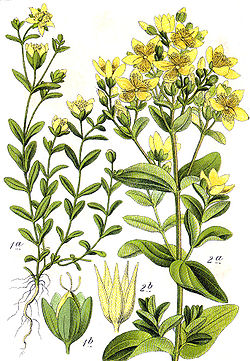| Hypericum tetrapterum | |
|---|---|
 | |
| Scientific classification | |
| Kingdom: | Plantae |
| Clade: | Tracheophytes |
| Clade: | Angiosperms |
| Clade: | Eudicots |
| Clade: | Rosids |
| Order: | Malpighiales |
| Family: | Hypericaceae |
| Genus: | Hypericum |
| Section: | Hypericum sect. Hypericum |
| Subsection: | Hypericum subsect. Hypericum |
| Series: | Hypericum ser. Hypericum |
| Species: | H. tetrapterum |
| Binomial name | |
| Hypericum tetrapterum | |
| Synonyms [2] | |
| |
Hypericum tetrapterum (syn. H. quadrangulum) is a herbaceous perennial plant species in the flowering plant family Hypericaceae. Its common names include St. Peter's wort, Peterwort, square stemmed St. John's wort, and square stalked St. John's wort.